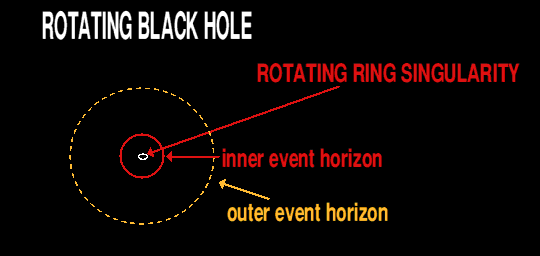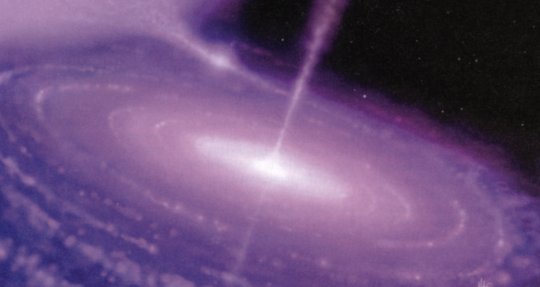

If we started off with a non-spinning black hole, it would have just one event horizon. If we imparted some spin to the black hole, then a sceond, inner event horizon would form near to the singularity. The singularity itself would also no longer be a single point in space-time, but a ring which lies in the plane of rotation.
If the speed of rotation is increased, the inner event horizon will grow larger whilst the outer event horizon will shrink. When the Black Hole has as much rotation as it can possibly acquire, then the two event horizons will coincide, leaving a naked ring singularity at the centre. No further rotation can be imparted to the black hole now. No one knows if naked singularities can exist, or what would be the consequences for the Universe if one did. The prospect is daunting.
Most objects in the universe are rotating, and any Black Holes that form are expected to be rotating. Rotating black holes are rather different from either charged or neutral black holes because the spin must occur in one plane. This produces a ring singularity instead of a point singularity. From whichever direction you approach a point singularity, you are guaranteed to end up at the singularity once you have entered the event horizon. You are doomed, doomed. But in the case of a ring singularity this is so only if you approach the ring edge-on. If you approach from any other angle, then you will go through the ring instead of into it, and moreover you will not experience infinitely curved space-time. Rather, you will come out the other side and enter negative space where gravity is repulsive instead of attractive. You enter an anti-gravity Universe!
Most substances have a positive specific heat: they get colder as they lose energy, but a rotating Black Hole can possess a negative specific heat: it gets hooter as it loses energy. The well known physicist, Paul Davies, recently discovered that the specific heat of a rotating Black Hole can change between positive and negative specific heat, depending upon the amount of spin the Black Hole possesses. He discovered that the specific heat flips from negative specific heat to positive specific heat when the square of its mass divided by the square of the spin parameter is equal to phi (the Golden Ratio, 1.6180339887...).
Any rotating body drags space-time around slightly. This is called frame-dragging. In the case of a very compact object like a Black Hole, any rotation will greatly affect the surrounding space-time, and any light that goes around the black hole will be affected by this frame-dragging. The light that goes on the side of the black hole with its spin going away from us will experience a different deflection than the light beam on the other side.
The ergo-sphere around a rotating Black Hole (outside the Schwartzschild radius) may exhibit negative refraction, and bend light rays passing through it the opposite way to that of gravity. The ergosphere around charged Black Holes may do likewise, as so too a positive value of the cosmological constant. This could affect the apparent positions of some bodies within the Universe.
Rotating black holes were mathematically investigated by Roy Kerr, and therefore are sometimes referred to as Kerr Black Holes.

Because the gravitational field of a mass is inversely proportional to the distance from the centre of a gravitating body, any two particles separated by a radial distance will experience a differing force; this is the tidal force which tends to stretch the separation distance of any two particles. The tidal force is proportional to the inverse cube of the distance from the centre of the mass. For a rotating Black Hole, the tidal force also depends upon the initial speed of the two particles. For high speed particles travelling greater than 0.7c, the tidal force depends upon the direction of travel of the two particles with respect to the spin axis of the Black Hole. For high-velocity particles travelling on the spin-axis, or within 55 degrees of that, Einsteins theory suggests that the particles are decelerated rather than accelerated. These are the on-axis jets of matter seen to be emited from Black Holes with accretion clouds. But, moreover, the theory also suggests that high-velocity particles outside that 55 degree angle, especially those at right-angles to the Black Holes' spin axis, are accelerated enormously, such that they can reach speeds close to c, with energies in excess of 1020 eV. Thus Black Holes could be spewing out highly energetic particles like protons, and this could be the source of the enigmatic primary cosmic rays with energies above 1019 eV. So the two jets either side of the Black Hole are only emitting lower energy particles, and it is the disc where much higher energy particles are emitted. Outside the Event Horizon of rotating Black Holes with accretion discs there is an enormous swirling magnetised plasma, this is the source of the accelerated particles.
![]()
![]()